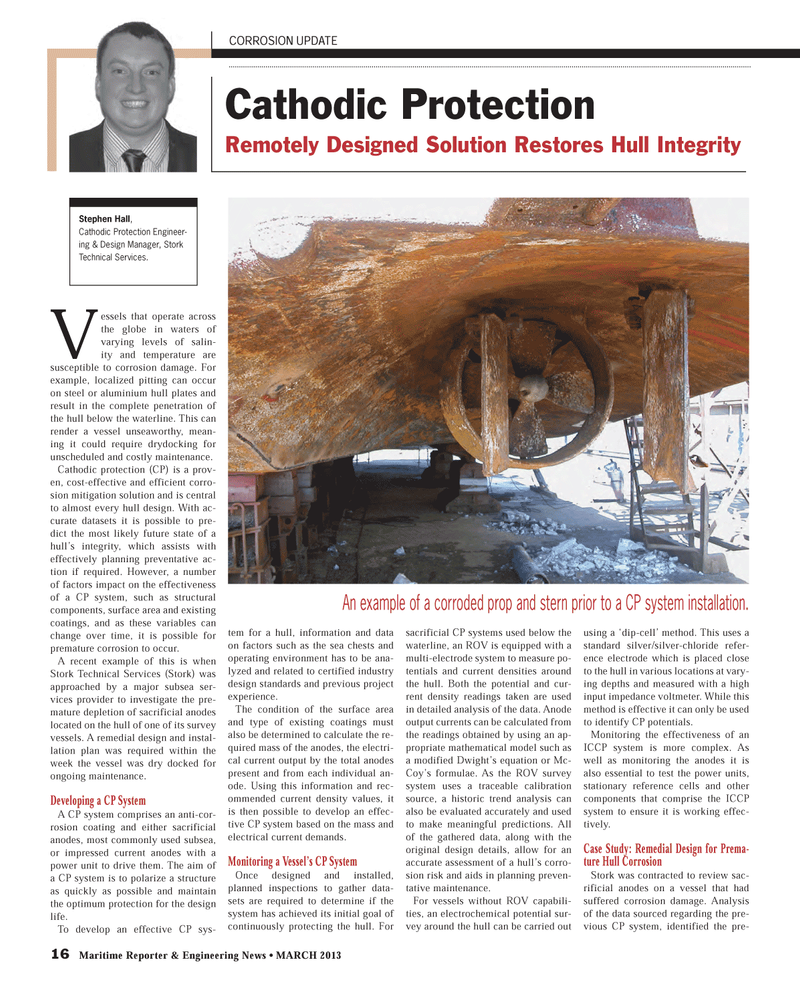
Page 16: of Maritime Reporter Magazine (March 2013)
U.S. Coast Guard Annual
Read this page in Pdf, Flash or Html5 edition of March 2013 Maritime Reporter Magazine
16 Maritime Reporter & Engineering News ? MARCH 2013 CORROSION UPDATE Cathodic Protection Stephen Hall, Cathodic Protection Engineer- ing & Design Manager, Stork Technical Services. Vessels that operate across the globe in waters of varying levels of salin-ity and temperature are susceptible to corrosion damage. For example, localized pitting can occur on steel or aluminium hull plates and result in the complete penetration of the hull below the waterline. This can render a vessel unseaworthy, mean- ing it could require drydocking for unscheduled and costly maintenance. Cathodic protection (CP) is a prov-en, cost-effective and efficient corro- sion mitigation solution and is central to almost every hull design. With ac- curate datasets it is possible to pre-dict the most likely future state of a hull?s integrity, which assists with effectively planning preventative ac- tion if required. However, a number of factors impact on the effectiveness of a CP system, such as structural components, surface area and existing coatings, and as these variables can change over time, it is possible for premature corrosion to occur. A recent example of this is when Stork Technical Services (Stork) was approached by a major subsea ser- vices provider to investigate the pre-mature depletion of sacrificial anodes located on the hull of one of its survey vessels. A remedial design and instal- lation plan was required within the week the vessel was dry docked for ongoing maintenance.Developing a CP System A CP system comprises an anti-cor- rosion coating and either sacrificial anodes, most commonly used subsea, or impressed current anodes with a power unit to drive them. The aim of a CP system is to polarize a structure as quickly as possible and maintain the optimum protection for the design life. To develop an effective CP sys- tem for a hull, information and data on factors such as the sea chests and operating environment has to be ana-lyzed and related to certified industry design standards and previous project experience. The condition of the surface area and type of existing coatings must also be determined to calculate the re-quired mass of the anodes, the electri-cal current output by the total anodes present and from each individual an-ode. Using this information and rec-ommended current density values, it is then possible to develop an effec- tive CP system based on the mass and electrical current demands.Monitoring a Vessel?s CP System Once designed and installed, planned inspections to gather data-sets are required to determine if the system has achieved its initial goal of continuously protecting the hull. For sacrificial CP systems used below the waterline, an ROV is equipped with a multi-electrode system to measure po-tentials and current densities around the hull. Both the potential and cur- rent density readings taken are used in detailed analysis of the data. Anode output currents can be calculated from the readings obtained by using an ap-propriate mathematical model such as a modified Dwight?s equation or Mc- Coy?s formulae. As the ROV survey system uses a traceable calibration source, a historic trend analysis can also be evaluated accurately and used to make meaningful predictions. All of the gathered data, along with the original design details, allow for an accurate assessment of a hull?s corro- sion risk and aids in planning preven-tative maintenance. For vessels without ROV capabili- ties, an electrochemical potential sur- vey around the hull can be carried out using a ?dip-cell? method. This uses a standard silver/silver-chloride refer- ence electrode which is placed close to the hull in various locations at vary-ing depths and measured with a high input impedance voltmeter. While this method is effective it can only be used to identify CP potentials. Monitoring the effectiveness of an ICCP system is more complex. As well as monitoring the anodes it is also essential to test the power units, stationary reference cells and other components that comprise the ICCP system to ensure it is working effec- tively. Case Study: Remedial Design for Prema- ture Hull Corrosion Stork was contracted to review sac-rificial anodes on a vessel that had suffered corrosion damage. Analysis of the data sourced regarding the pre-vious CP system, identified the pre- Remotely Designed Solution Restores Hull Integrity An example of a corroded prop and stern prior to a CP system installation. MR #3 (10-17).indd 16MR #3 (10-17).indd 162/26/2013 3:41:34 PM2/26/2013 3:41:34 PM

 15
15

 17
17
